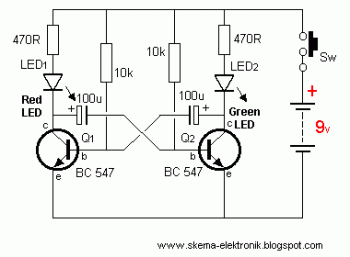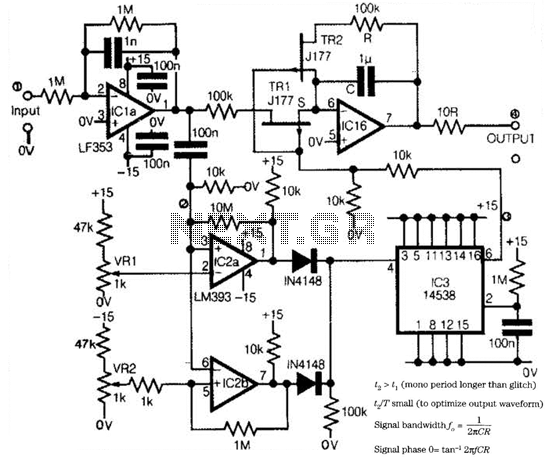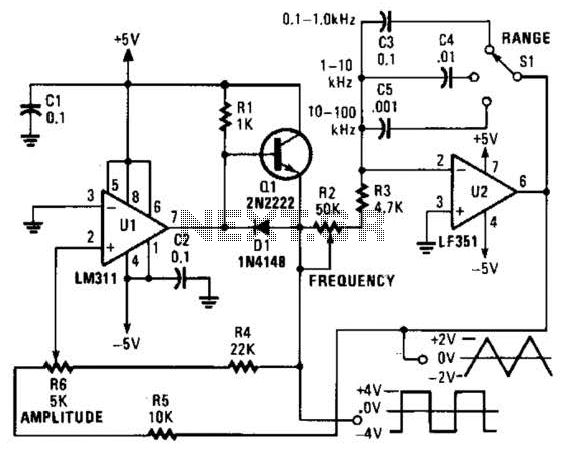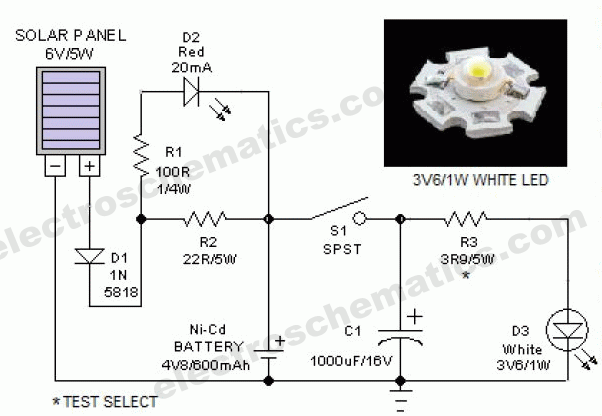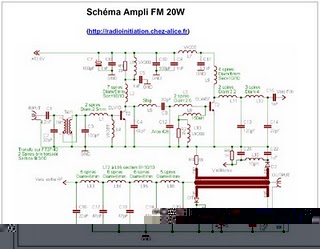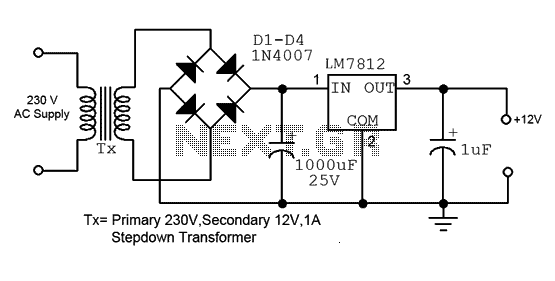
lm567-mp1826 precision timer circuit diagram
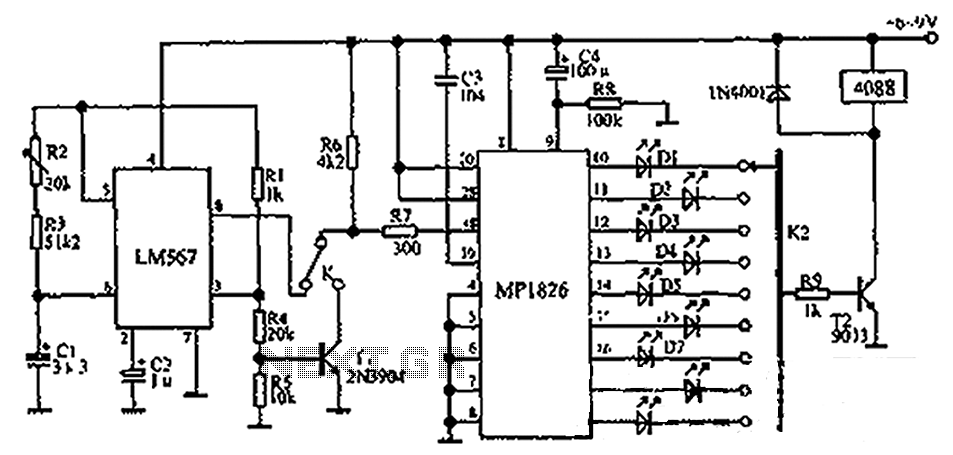
The circuit illustrated in the figure incorporates the MP1826 as a multi-stage divider. The LM567 serves as the frequency demodulation component, functioning as a dual-band oscillator that generates the desired low-frequency pulse from the MP1826. The oscillation center frequency (f0) is determined by capacitor C1 and resistors R2 and R3. The output from the LM567's third pin provides f0, while the eighth pin outputs 2f0. By adjusting the circuit's time constant, f0 can vary between 0.01 Hz and 500 kHz, with the specific circuit setting f0 at 4 Hz. Upon powering the circuit, the MP1826 undergoes a reset, during which diode D1 flashes several times before turning off. The low-frequency pulse is input to the MP1826, causing pin 10 to go high after a time interval T, followed by pin 11 also going high after a time interval T2, and subsequently pin 10 returns to a low state. This sequence continues through pins 12 to 17. When pin 8 is grounded, after a duration of 105 times T2, pin 24 transitions to a high state, indicating the expiration of the circuit timer. The circuit is designed to allow for timing adjustments without altering the parameters of the components, providing a timing gear of 18.
The MP1826 operates as a multi-stage frequency divider, which is particularly effective for generating low-frequency signals from a higher frequency input. The LM567, a versatile phase-locked loop (PLL) integrated circuit, is utilized for demodulating frequency signals. It is capable of processing dual-band frequencies, making it suitable for applications that require precise frequency generation and demodulation.
In this configuration, the oscillator's frequency (f0) is primarily determined by the values of C1, R2, and R3. The relationship between these components and the output frequency can be expressed through the formula f0 = 1/(2πRC), where R is the equivalent resistance and C is the capacitance in the timing circuit. The ability to adjust the time constant by changing these component values allows for a broad frequency range, thus enhancing the circuit's versatility.
The operation sequence begins with the activation of the circuit, during which the MP1826 resets, indicated by the flashing of D1. This initial state is crucial for ensuring that the circuit starts from a known condition. Following the reset, the low-frequency pulse generated at the output of the MP1826 is fed into the circuit, triggering a series of events that manipulate the state of various output pins. The timing intervals T and T2 are critical for controlling the transitions of pins 10 and 11, which in turn influence the subsequent states of pins 12 through 17.
The grounding of pin 8 serves as a control mechanism that initiates the timing sequence, culminating in the high state of pin 24 after a predetermined duration. This feature allows the circuit to function effectively as a timer, providing a timing gear of 18 without necessitating modifications to the component values. Such functionality is beneficial in applications where precise timing and frequency control are essential, such as in communication systems, signal processing, and automated control systems. Overall, the circuit's design emphasizes flexibility and precision in frequency generation and timing applications. As shown in FIG, MP1826 in the circuit as a multi-stage divider. LM567 is the frequency demodulation circuit, the circuit as a dual-band oscillator which generates the desired low-frequency pulse MP1826. Whose oscillation center frequency f0 determined by C1, R2, R3. f0 by a 3-pin output LM567, the 8-pin output 2f0. Changing circuit time constant, f0 may vary between 0.01Hz ~ 500kHz. This circuit f0 is 4Hz. When the circuit is turned on to work first MP1826 reset, then you can see D1 flashes a few times off. Low-frequency pulse input MP1826, after time T, 10 pin goes high, 11 feet and then after time T2 goes high, pin 10 goes low; the process of 12 to 17 feet and so on.
When the 8-foot ground, after 105XT2 time, 24 pin goes high. Circuit timer expires. Circuit without changing element parameters can have a timing gear 18.
The MP1826 operates as a multi-stage frequency divider, which is particularly effective for generating low-frequency signals from a higher frequency input. The LM567, a versatile phase-locked loop (PLL) integrated circuit, is utilized for demodulating frequency signals. It is capable of processing dual-band frequencies, making it suitable for applications that require precise frequency generation and demodulation.
In this configuration, the oscillator's frequency (f0) is primarily determined by the values of C1, R2, and R3. The relationship between these components and the output frequency can be expressed through the formula f0 = 1/(2πRC), where R is the equivalent resistance and C is the capacitance in the timing circuit. The ability to adjust the time constant by changing these component values allows for a broad frequency range, thus enhancing the circuit's versatility.
The operation sequence begins with the activation of the circuit, during which the MP1826 resets, indicated by the flashing of D1. This initial state is crucial for ensuring that the circuit starts from a known condition. Following the reset, the low-frequency pulse generated at the output of the MP1826 is fed into the circuit, triggering a series of events that manipulate the state of various output pins. The timing intervals T and T2 are critical for controlling the transitions of pins 10 and 11, which in turn influence the subsequent states of pins 12 through 17.
The grounding of pin 8 serves as a control mechanism that initiates the timing sequence, culminating in the high state of pin 24 after a predetermined duration. This feature allows the circuit to function effectively as a timer, providing a timing gear of 18 without necessitating modifications to the component values. Such functionality is beneficial in applications where precise timing and frequency control are essential, such as in communication systems, signal processing, and automated control systems. Overall, the circuit's design emphasizes flexibility and precision in frequency generation and timing applications. As shown in FIG, MP1826 in the circuit as a multi-stage divider. LM567 is the frequency demodulation circuit, the circuit as a dual-band oscillator which generates the desired low-frequency pulse MP1826. Whose oscillation center frequency f0 determined by C1, R2, R3. f0 by a 3-pin output LM567, the 8-pin output 2f0. Changing circuit time constant, f0 may vary between 0.01Hz ~ 500kHz. This circuit f0 is 4Hz. When the circuit is turned on to work first MP1826 reset, then you can see D1 flashes a few times off. Low-frequency pulse input MP1826, after time T, 10 pin goes high, 11 feet and then after time T2 goes high, pin 10 goes low; the process of 12 to 17 feet and so on.
When the 8-foot ground, after 105XT2 time, 24 pin goes high. Circuit timer expires. Circuit without changing element parameters can have a timing gear 18.
